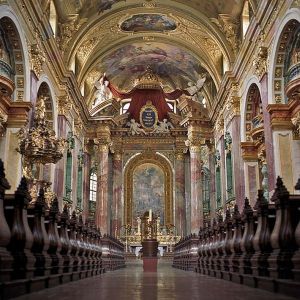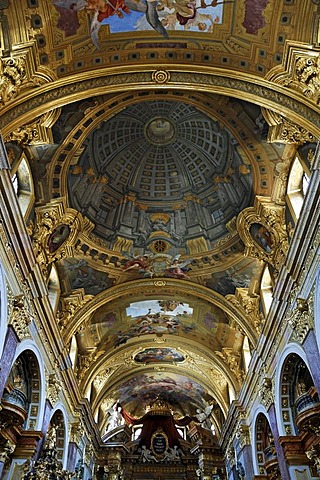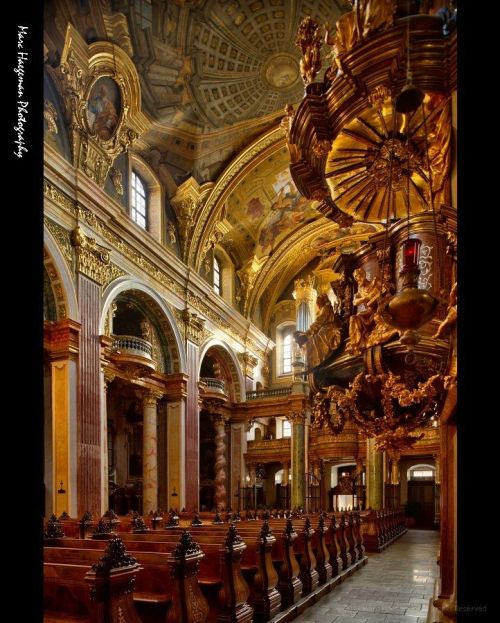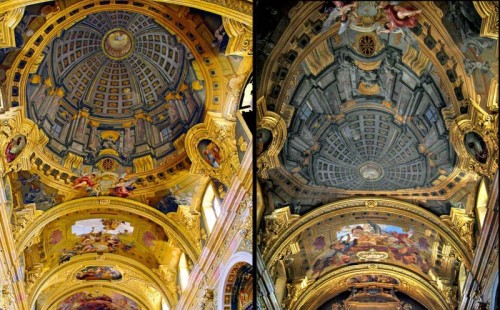INTRO
The baroque era was filled with talented artist that created monumental ceiling paintings that looked like illusions. The intricate details and distortions needed to pull it off are beyond amazing. The time it took to plan and put that plan in action was years in the making (Encyclopedia.com).
Andrea Pozzo was one of the finest artists of illusionist mural painting of the Baroque era. He specialized in quadatura and di sotta in su to create illusion of three-dimensional space on a flat-ceiling above viewers. Pozzo was born in Austrian- ruled Trento. In 1659 he was apprenticed to a local painter. On Christmas Day 1665, he joined the Jesuit Order as a lay brother. His door into the world of quadatura and di sotto in su and other illusionistic techniques came around in part by the artistic needs of the Catholic Church’s Jesuit Order. Many of the new churches lacked decorative interiors. He became world famous for the trome l’oeil techniques, such as fake gilding, marbled columns, bronze- coloured statues, fake domes on flat ceilings.
Pozzo work mainly involved Catholic and particularly Jesuit themes, he was indebted to the theatre. Through his artistic skills he constructed large dramas featuring a proscenium arch, a curtain, and a backdrop. His innovations regarding perspective continue to show their influences, pin pointing them as the foundation to much more modern design.
The Jesuit Church in Vienna is a two- floor, double tower church. Heavy influence of Baroque principles, the church was remodeled by Andrea Pozzo between 1703 and 1705. The church itself was built between 1623 and 1627 on the site of an earlier chapel. Pozzo was requested by Emperor Leopold I to redecorate the church. He added twin towers and modify the façade in an early baroque style. The semicircular vault ceiling was divided in four bays with paintings in perspective, using illusionary techniques.
The Council of Trent
Pope Paul III was considered to be the first pop of the Counter- Reformation, and also the initiator of the Council of Trent. The council was a commission of Cardinals tasked with institutional reform, addressing controversial issues such as corrupt bishops and priests, indulgences, and other financial abuses. The council upheld the basic structure of the medieval church, the sacramental system, religious orders and doctrine. (Wiki) The church rejected all compromise with the Protestants, restating the basic tenets of the Roman Catholic Faith. The Council of Trent proclaimed that painting, architecture, and sculpture had a role to play into conveying Catholic Theology. Any piece of artwork that might have aroused “carnal desire” was inadmissible in Church, while any depiction of Christ’s suffering and explicit agony was desirable and proper.
According to them arts should communicate religious themes in direct and emotional involvement. The aristocracy also saw the dramatic style of baroque architecture and art as a means of impressing visitors and expressing triumph, power and control. Pozzo was hired for multiple pieces in churches and palaces by the Council of Trent. His ceilings were meant to instill faith along with a connection with god through the spectacular detail of the painting.
The vast detail and the amazing three- dimensional feel of the painting really blows my mind. The fact that he had to distort the painting to make it three dimensional is utterly amazing to me for that time. Looking at even just pictures, you can feel the majestic tone and richness of the paintings. The realism of the dome is in itself spectacular. I look it and still can’t believe that it was done all those years ago. With the advancement in science and art in the present to me it would seem that this could have been now rather than back then.
Sources
http://www.encyclopedia.com/topic/Andrea_dal_Pozzo.aspx
Encyclopedia.com. “Andrea dal Pozzo”. Encyclopedia.com. 2015. Web
http://www.pbs.org/empires/medici/renaissance/counter.html
PBS. “Counter Reformation”. PBS. Delillier Donegan Enterprise. n.d. Web.
https://en.wikipedia.org/wiki/Jesuit_Church,_Vienna
 contributors. “Jesuit Church, Vienna.” Wikipedia, The Free Encyclopedia. Wikipedia, The Free Encyclopedia, 14 Sep. 2015.
contributors. “Jesuit Church, Vienna.” Wikipedia, The Free Encyclopedia. Wikipedia, The Free Encyclopedia, 14 Sep. 2015.
https://en.wikipedia.org/wiki/Illusionistic_ceiling_painting
Wikipedia contributors. “Illusionistic ceiling painting.” Wikipedia, The Free Encyclopedia. Wikipedia, The Free Encyclopedia, 10 Sep. 2015. Web. 5 Oct. 2015.
https://en.wikipedia.org/wiki/Counter-Reformation#Council_of_Trent
Wikipedia contributors. “Counter-Reformation.” Wikipedia, The Free Encyclopedia. Wikipedia, The Free Encyclopedia, 30 Sep. 2015. Web. 5 Oct. 2015.






Chan
October 7, 2015 at 3:55 AM
Great blog! These paints on the walls just goes to show just how much talent people actually have. Its amazing that Andrea Pozzo is able to make paintings look so three dimensional. It also surprises me how people were able to figure out how to make paintings on walls and ceilings look three dimensional. I can’t say that I have a painting that I particularly favor because I think that if you are able to paint something to look three dimensional then you should be praised the exact same. Which makes me wonder if you have a particular piece that you favor?
LikeLike
hiukkagoddess
October 7, 2015 at 5:45 AM
Honestly I can’t say that I have a favorite. Every piece of art is unique and has different attributes that I love and would love to learn how to creat myself. I love looking at what others view art as and their own creations and how different everyone is.
LikeLike
maccolum
October 8, 2015 at 3:59 AM
Good post. It is amazing what the artists of that time were able to create utilizing unknown and unproven techniques. Its easy to see how the use of illusion was utilized to create those amazing three dimensional appearing pieces and you can see how those techniques are still in use today and how they have been adapted in the current generation. Here’s a link to some great illusion art that is done today and you can clearly see the influences that were provided. http://www.bitrebels.com/design/76-unbelievable-street-and-wall-art-illusions/
LikeLike